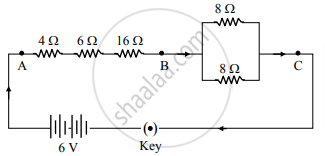Advertisements
Advertisements
प्रश्न
State the law of combination of resistances in parallel.
उत्तर
In a parallel combination, the voltage remains the same across each resistor but the current gets divided. Let I1, I2 and I3 be the current across resistors R1, R2 and R3, respectively.
`l=l_1+l_2+l_3`
`V=LR,V=L_1R_1,L_2R_2, V=L_3R_3`
`I=v/R,I_1 V/R_1, I_2=V/R_2,L_3 V/R_1`
Using thrsr value, We get:
`V/R=V/R_1+V/R_2+V/R^1`
`1/R=1/R_1+1/R_2+1/R_1`
So, the total resistance is the sum of the reciprocal of the individual resistances.
APPEARS IN
संबंधित प्रश्न
A resistor has a resistance of 176 ohms. How many of these resistors should be connected in parallel so that their combination draws a current of 5 amperes from a 220 volt supply line?
State how are the two resistors joined with a battery when potential difference is same across each resistor.
Two resistors having resistance 4𝛀 and 6𝛀 are connected in parallel. Find their equivalent resistance.
A battery of e.m.f 16 V and internal resistance 2 Ω is connected to two resistors 3Ω and 6Ω connected in parallel. Find:
- the current through the battery.
- p.d. between the terminals of the battery,
- the current in 3 Ω resistors,
- the current in 6 Ω resistor.
A uniform wire with a resistance of 27 Ω is divided into three equal pieces and then they are joined in parallel. Find the equivalent resistance of the parallel combination.
What are the advantages of a parallel connection?
Two resistors of resistance 4 Ω and 6 Ω are connected in parallel to a cell to draw 0.5 A current from the cell.
Draw a labeled diagram of the arrangement
A particular resistance wire has a resistance of 3 ohm per meter. Find :
The total resistance of three lengths of this wire each 1.5 m long, in parallel.
The least resistance obtained by using 2 Ω, 4 Ω, 1 Ω and 100 Ω is:
Study the following circuit:

On the basis of this circuit, answer the following questions:
i. Find the value of total resistance between the points A and B.
ii. Find the resistance between the points B and C.
iii. Calculate the current drawn from the battery, when the key is closed
OR
iii. In the above circuit, the 16Ω resistor or the parallel combination of two resistors of 8 Ω, which one of the two will have more potential difference across its two ends? Justify your answer.
